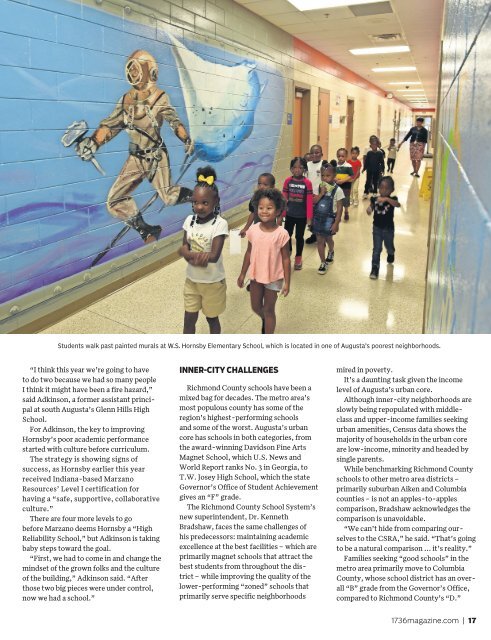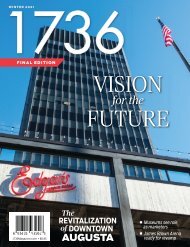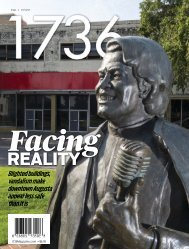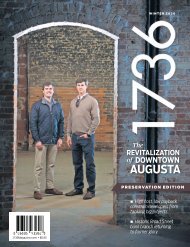Education Edition - 1736 Magazine, Fall 2019
- No tags were found...
You also want an ePaper? Increase the reach of your titles
YUMPU automatically turns print PDFs into web optimized ePapers that Google loves.
Students walk past painted murals at W.S. Hornsby Elementary School, which is located in one of Augusta’s poorest neighborhoods.<br />
“I think this year we’re going to have<br />
to do two because we had so many people<br />
I think it might have been a fire hazard,”<br />
said Adkinson, a former assistant principal<br />
at south Augusta’s Glenn Hills High<br />
School.<br />
For Adkinson, the key to improving<br />
Hornsby’s poor academic performance<br />
started with culture before curriculum.<br />
The strategy is showing signs of<br />
success, as Hornsby earlier this year<br />
received Indiana-based Marzano<br />
Resources’ Level I certification for<br />
having a “safe, supportive, collaborative<br />
culture.”<br />
There are four more levels to go<br />
before Marzano deems Hornsby a “High<br />
Reliability School,” but Adkinson is taking<br />
baby steps toward the goal.<br />
“First, we had to come in and change the<br />
mindset of the grown folks and the culture<br />
of the building,” Adkinson said. “After<br />
those two big pieces were under control,<br />
now we had a school.”<br />
INNER-CITY CHALLENGES<br />
Richmond County schools have been a<br />
mixed bag for decades. The metro area’s<br />
most populous county has some of the<br />
region’s highest-performing schools<br />
and some of the worst. Augusta’s urban<br />
core has schools in both categories, from<br />
the award-winning Davidson Fine Arts<br />
Magnet School, which U.S. News and<br />
World Report ranks No. 3 in Georgia, to<br />
T.W. Josey High School, which the state<br />
Governor’s Office of Student Achievement<br />
gives an “F” grade.<br />
The Richmond County School System’s<br />
new superintendent, Dr. Kenneth<br />
Bradshaw, faces the same challenges of<br />
his predecessors: maintaining academic<br />
excellence at the best facilities – which are<br />
primarily magnet schools that attract the<br />
best students from throughout the district<br />
– while improving the quality of the<br />
lower-performing “zoned” schools that<br />
primarily serve specific neighborhoods<br />
mired in poverty.<br />
It’s a daunting task given the income<br />
level of Augusta’s urban core.<br />
Although inner-city neighborhoods are<br />
slowly being repopulated with middleclass<br />
and upper-income families seeking<br />
urban amenities, Census data shows the<br />
majority of households in the urban core<br />
are low-income, minority and headed by<br />
single parents.<br />
While benchmarking Richmond County<br />
schools to other metro area districts –<br />
primarily suburban Aiken and Columbia<br />
counties – is not an apples-to-apples<br />
comparison, Bradshaw acknowledges the<br />
comparison is unavoidable.<br />
“We can’t hide from comparing ourselves<br />
to the CSRA,” he said. “That’s going<br />
to be a natural comparison ... it’s reality.”<br />
Families seeking “good schools” in the<br />
metro area primarily move to Columbia<br />
County, whose school district has an overall<br />
“B” grade from the Governor’s Office,<br />
compared to Richmond County’s “D.”<br />
<strong>1736</strong>magazine.com | 17<br />
1117_T_13_AM____.indd 17<br />
10/25/<strong>2019</strong> 11:51:12 AM
















